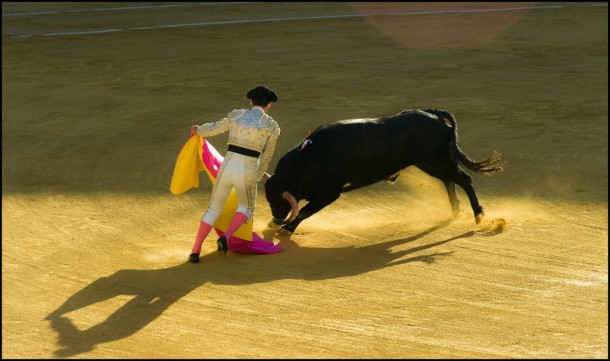I attended a bullfight in Madrid last week. The sport is incredibly popular in Spain and has been made legendary by its cultural and historical significance along with the controversial animal rights position. Here I will talk about what actually happens in the fight as well as giving my own take on this famed activity.
Layout
In the format I experienced, taking place at the spectacular Las Ventas stadium in northern Madrid, there is a strict procedure for each bull. The ticket I purchased involved three senior matadors and six bulls, all six of which would die. For each animal there is a first round of charging and evading with the younger men in the ring. The bull, contrary to popular opinion, is not incensed by the colour red (they are colour-blind) but by the rapid movement of the fabric. This is followed by armoured horses interacting with the bull, before a number of lances are struck into the bull’s back to weaken it. This is then followed, theoretically, by another display by the senior man in the ring who then thrusts a sword into its heart and kills it. Another member will ensure it is dead by stabbing the brain of the downed creature.
Complications
As someone who has never seen this activity live before you are caught between a rock and a hard place. On the one hand you sort of want the bull to somehow escape its bloody fate, yet you know it is impossible and would also probably entail numerous harrowing human deaths or mutilations. And that’s even without mentioning that the locals around you are crying out for the bull’s blood to be spilt and cheer whenever a sword or lance finds its mark. In my fight there were no major hiccups but a few apparent diversions from the original plan. In one remarkable scene a bull with several lances in its back caught its horns in the ground, flipped over and dislodged them from its spine. In another strange moment one matador slipped and was almost trampled by the bull. But the bits most difficult to watch were when the matador failed to quickly deliver the final blow. The last two bulls were seemingly dealt with by a much younger man who took several tries to finally down the animal and this part included jeers from the crowd and the painful sound of the bull’s tortured cries.
Perspective
A massive split in opinion exists regarding the purpose, artistic merit and legality of bullfighting. Having attended an actual fight it is possible to see both sides of the argument. Spaniards who partake in the activity talk about the courage of the matadors and how this is the most glorious and beautiful end to the bull’s life. It undoubtedly takes something to get in the ring with that thing: whether that is bravery or foolishness I’m still unsure. The aesthetic argument is also difficult. Elements of the event are indeed pretty to behold but the actual act of the bull’s wounding and eventual death, in particular when it is dragged out, is hard to square with this talk of beauty. That said, Hemingway’s words in Death in the Afternoon (1932) undeniably reverberates: “Bullfighting is the only art in which the artist is in danger of death and in which the degree of brilliance in the performance is left to the fighter’s honour.” There truly is nothing like it. It is a show of cruelty and pain but Spaniards who enjoy the sport simply cannot understand that.
Whilst I am glad I got to experience a bullfight here I cannot condone the activity. If anyone is visiting somewhere which practices this sport then by all means attend but go in with your eyes open. For better or worse, it certainly won’t be something you will quickly forget.

